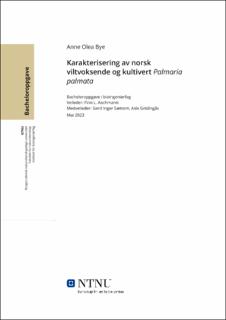| dc.description.abstract | Tarearten Palmaria Palmata (P. palmata) er én av flere tarearter som vokser langs kysten i Norge. Verden er stadig på jakt etter nye matressurser, og med verdens nest lengste kystlinje har Norge et stort potensial for kultivering av makroalger. Det er få aktører som har kultivert arten P. palmata frem til nå, på grunn av at den er mindre i størrelse enn andre makroalger, og dermed vanskeligere å høste i store volum. En oppstartsbedrift ved navn Norwegian Seaweed AS har kultivert P. palmata for første gang i sesongen 2022/2023. Miljøet påvirker næringsinnholdet i makroalger. I den forbindelse er det behov for å karakterisere den kjemiske sammensetningen i den kultiverte varianten, for å sammenligne med viltvoksende P. palmata.
Oppgaven er tilknyttet Seaweed Biorefinery Platform Norway (SPB-N) ved Norges Teknisk-Naturvitenskapelige Universitet (NTNU) i Trondheim. Materialet i oppgaven er levert av SINTEF Industri og Norwegian Seaweed AS (NSAS). Tre ulike tareprøver av arten P. palmata var utgangspunktet for oppgaven. Én av prøvene var fra viltvoksende P. palmata, og to prøver var fra kultivert P. palmata under to ulike vekstforhold. Den ene ble dyrket med høyere eksponering av lys og mer bevegelsesrom enn den andre. I de tre tareprøvene ble den kjemiske sammensetningen karakterisert ut fra innhold av tørrstoff, aske, proteiner, aminosyrer, monosakkarider, samt innhold av karbon, nitrogen, hydrogen og svovel og tungmetaller.
Tørrstoff- og askemengden var høyest i kultivert P. palmata. Det var små forskjeller mellom de to kultiverte prøvene. Det ble detektert en større mengde karbon, nitrogen, hydrogen og svovel i viltvoksende P. palmata enn i kultivert P. palmata. Proteininnhold i viltvoksende P. palmata hadde også et høyere resultat enn i de kultiverte prøvene. Fra bestemmelse av aminosyrer ble det gjort funn av at kultivert P. palmata som hadde vokst med mindre lyseksponering og rom for bevegelse hadde et mye høyere innhold av glutaminsyre enn den mer lyseksponerte prøven. Et høyt innhold av xylose ble funnet i alle tre prøvene. Det ble gjort funn av et lavere innhold av jod og kadmium i de to kultiverte prøvene enn i viltvoksende P. palmata. Innholdet av arsen var høyere i den kultiverte prøven med høyest lyseksponering og bevegelsesrom. Det oppfordres til videre forskning med flere prøver for å optimalisere resultatene. | |
| dc.description.abstract | The macroalgae Palmaria Palmata (P. palmata) is one of several macroalgae species that grow along the coast of Norway. With the world in constantly search of new food resources, Norway has great potential for the cultivation of macroalgae with its long coastline. Until now, there have been few actors who have cultivated P. palmata due to its smaller size compared to other macroalgae, making it more challenging to harvest in large volumes. A startup company named Norwegian Seaweed AS has cultivated P. palmata for the first time in the 2022/2023 season. The environment around the macroalgae can affect the nutrient content. In this regard, there is a need to characterize the composition of the cultivated variant of P. palmata and compare it with wild P. palmata.
The study is associated with the Seaweed Biorefinery Platform Norway (SPB-N) at the Norwegian University of Science and Technology (NTNU) in Trondheim. The material for the study was provided by SINTEF Industry and Norwegian Seaweed AS (NSAS). Three different samples of P. palmata were used for the study: one sample from wild-grown P. palmata, and two samples from cultivated P. palmata under different growth conditions. One sample was grown with higher light exposure and more space for movement compared to the other. The composition of the three seaweed samples was characterized based on their dry matter, ash, proteins, amino acids, monosaccharides, as well as carbon, nitrogen, hydrogen, sulfur, and element content.
The cultivated P. palmata had the highest amount of dry matter and ash, while there were minor differences between the two cultivated samples. A higher amount of carbon, nitrogen, hydrogen, and sulfur was detected in wild P. palmata compared to cultivated P. palmata. The protein content in wild P. palmata was also higher than in the cultivated samples. From the determination of amino acids, it was found that the cultivated P. palmata, which had grown with less light exposure and less space, had a significantly higher content of glutamic acid compared to the more light-exposed sample. A remarkably high content of xylose was found in all three samples. Lower levels of iodine and cadmium were found in the two cultivated samples compared to wild P. palmata. The content of arsenic was noticeably higher in the more light-exposed cultivated sample with more room for space. To optimize the results, further research with more samples is recommended. | |
